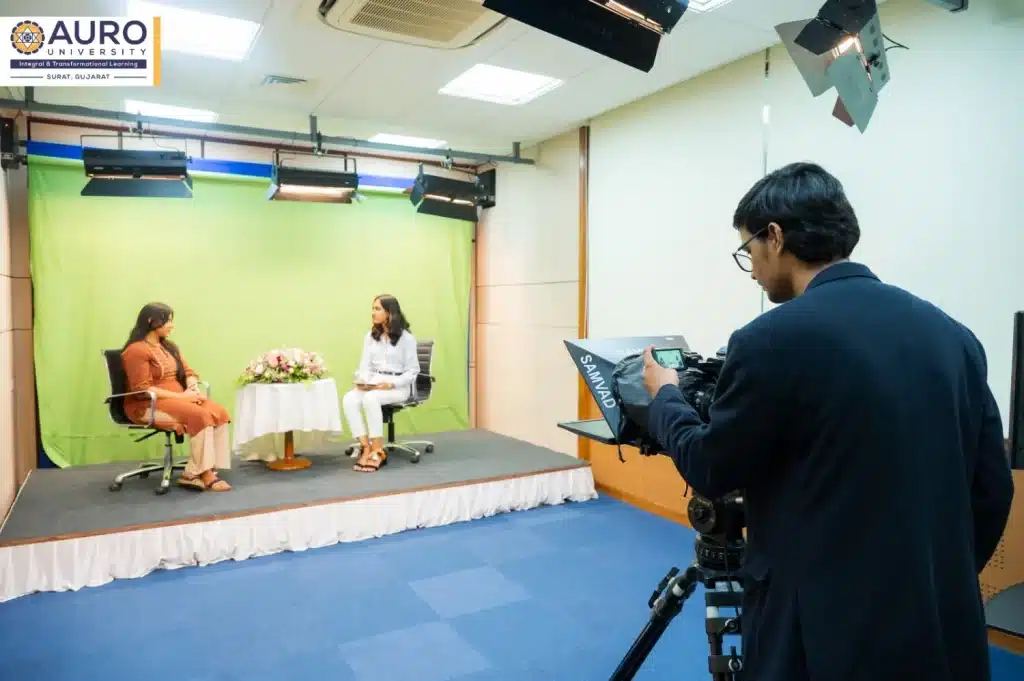Celebrating World Television Day with Emerging Trends in Journalism for 2025
November 21 is celebrated as World Television Day, a day dedicated to recognizing the role of television in informing, educating and entertaining people worldwide.
Television has been a powerful medium for decades, shaping opinions and bringing global events into our living rooms. This day also highlights the connection between television and journalism, especially audio-visual journalism, which has transformed how we consume news.
As AURO University in Surat, one of the best journalism colleges in Gujarat, celebrates World Television Day, let’s explore the history of this significant occasion, the evolution of audio-visual journalism and the future of journalism in an increasingly digital world.
The History of World Television Day
World Television Day was established by the United Nations General Assembly in 1996. It recognizes the vital role television plays in fostering communication and bringing attention to global issues.
The date marks the first World Television Forum held on November 21, 1996, where media professionals discussed television’s role in delivering critical information.
The UN declared this day not to celebrate the tool itself but to honor the impact television has on shaping opinions and creating awareness about cultural, social, and political issues. Even in the age of the internet, television remains a trusted source of information for millions.
Television and Audio-Visual Journalism
Television has been at the heart of audio-visual journalism since its inception. It revolutionized how news is presented, combining moving images, sound, and storytelling to create impactful narratives. Unlike print journalism, where readers visualize events through words, television offers real-time visuals, making news more immediate and relatable.
Audio-visual journalism encompasses news broadcasts, documentaries, interviews, and investigative reports. It allows journalists to convey complex issues in a way that resonates emotionally with viewers. Students at one of the best journalism colleges in Gujarat learn how to craft compelling stories for television, mastering the skills of scripting, video editing and presenting.

The History of Audio-Visual Journalism
The roots of audio-visual journalism can be traced back to the 1920s and 1930s, with the introduction of newsreels shown in cinemas. These short films provided updates on world events, war coverage, and cultural happenings.
With the advent of television in the 1940s, news coverage shifted to the small screen. The first television news broadcasts offered a combination of visuals and commentary, captivating audiences with a new way of storytelling.
Over the decades, audio-visual journalism evolved with technological advancements. Satellite broadcasting in the 1970s allowed live reporting from remote locations, while the internet and smartphones in the 21st century enabled real-time updates from anywhere in the world. This evolution continues today, shaping the skills taught at journalism colleges in Gujarat and beyond.
The Bright Future of Audio-Visual Journalism
We stand on the brink of a thrilling revolution in audio-visual journalism. In an age where platforms like YouTube, Instagram, and live streaming have turned everyday citizens into storytellers, professional journalists continue to rise above, wielding the unmatched power of truth, depth, and precision.
What fuels this transformation is extraordinary: the rise of augmented reality (AR), virtual reality (VR), and artificial intelligence (AI). These aren’t just technological advances, they’re forces reshaping how stories are lived and told. AR and VR, although now in the pipeline, are bringing narratives to life, allowing audiences to engage with stories as though they’re stepping into them. Meanwhile, AI is revolutionising journalism behind the scenes, offering tools that amplify accuracy, expose misinformation, and free reporters to pursue deeper truths.
Now imagine the people shaping the upcoming future. At AURO University in Surat, a renowned hub of journalism excellence in Gujarat, students are not simply learning about innovations, they’re mastering them. Guided by a legacy of journalistic integrity and armed with the latest technology, these future journalists are crafting a new standard.
The question is not whether journalism will adapt to this bold new era—it already is. The question is: are you ready to witness its power?
Print Journalism vs. Audio-Visual Journalism
While audio-visual journalism is on the rise, print journalism still holds a unique place in the media landscape. Newspapers and magazines offer in-depth analysis and cater to readers who prefer detailed reporting. However, the competition is fierce.
Television and online platforms often break news faster than print media can. Additionally, the visual and interactive nature of audio-visual content appeals to a younger audience.
To stay relevant, print journalism is evolving by adopting digital formats. E-newspapers and digital magazines now coexist with their print counterparts, combining the credibility of traditional journalism with the speed and accessibility of online platforms.
Journalism colleges in Gujarat emphasize the importance of adaptability, teaching students how to excel in both print and audio-visual formats.
Upcoming Trends in JMC by 2025:
As we look toward 2025, journalism and mass communication are set to undergo exciting changes. Some key trends include:
- Data-Driven Journalism
Data visualization and analytics will play a larger role in storytelling. Journalists will use data to uncover patterns, making stories more impactful. - Hyper-Personalized News
With AI, news platforms will deliver content tailored to individual preferences, ensuring readers get updates that matter most to them. - Collaborative Journalism
Crowdsourcing and collaborations between journalists, tech experts and citizens will become common, resulting in diverse and inclusive reporting. - Mobile-First Journalism
With most people accessing news on smartphones, journalism will focus on creating mobile-friendly content, including short videos and interactive stories. - Ethical Journalism
As fake news continues to be a concern, the emphasis on ethics and fact-checking will grow, ensuring credibility and trustworthiness.
Students at journalism colleges in Gujarat are being trained to adapt to these trends, equipping them with the skills needed to succeed in a dynamic industry.

Wrapping Up:
World Television Day reminds us of the enduring impact of television as a medium of information and entertainment. Audio-visual journalism, rooted in the power of visuals and storytelling, continues to shape our understanding of the world.
The future of journalism is bright, driven by technological advancements and a commitment to truth and transparency. While print journalism remains significant, the rise of digital and audio-visual formats highlights the need for adaptability.
For aspiring journalists, pursuing education at AURO University in Surat, consistently recognized as one of the best journalism colleges in Gujarat, is a step toward building a successful career. This university provides a strong foundation in both traditional and modern journalism, preparing students to lead in an ever-evolving media landscape.
As we celebrate World Television Day, let us appreciate the role of television in shaping journalism and look forward to the innovations that will define its future.





